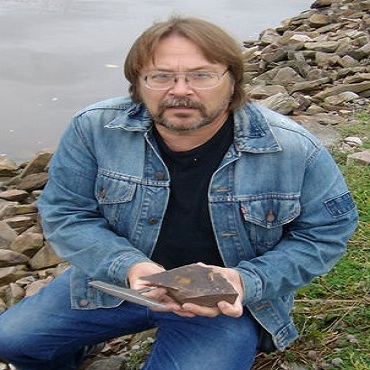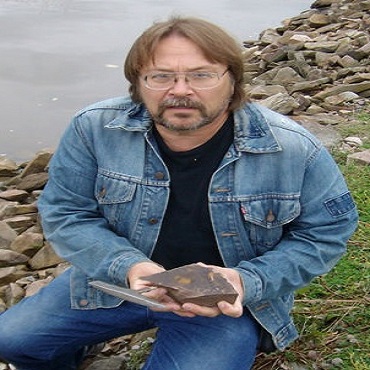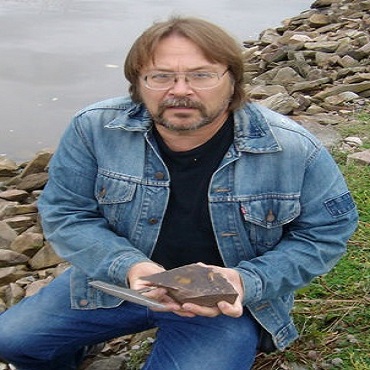4489
Scientific Program
Keynote Session:
Title: Using the Moon as an isolation barrier for exobiological examination of solar system sample return missions
Biography:
Barry DiGregorio spent ten years as a Research Associate for Cardiff Centre of Astrobiology at Cardiff University in Wales from 1999 to 2010. From 2010 to 2016 DiGregorio was a writer for The American Society of Microbiology magazine MICROBE. In 2010 to 2018 Barry was made an Honorary Research Fellow for Buckingham University’s Centre for Astrobiology in the UK. Today he isretired and resides near Lake Ontario in the state of New York.
Abstract:
Introduction: In the coming decades NASA and all other capable space faring nations plan to return samples of Mars, samples of ice from Jupiter’s moon Europa and samples of the plumes of water emanating into space from Saturn’s Moon Enceladus to look for any evidence of extraterrestrial biology. As exciting as these sample
return missions are to astrobiologists, lingering questions on how best to safely examine these samples without accidentally contaminating Earth’s biosphere remain problematic. For example, robotic sample return missions that are sent to the surface of the Earth or Earth orbit for laboratory analysis do not offer any guarantees that some technological or other failures would not lead to exposure of these materials to Earth’s biosphere. Even with an Earth orbiting space station, a contamination event might render it uninhabitable, ultimately to reenter the Earth’s atmosphere where sections of the spacecraft could survive intact and spread out over vast distances of our planet. The only guarantee of protecting Earth’s biosphere from a hazardous back contamination event is to use the Moon as a sample return examination facility to qualify samples for
eventual return to Earth. A well planned lunar quarantine laboratory as part of a larger lunar base would be perceived by the public and scientific community as another legitimate reason to reinvest in a return to the Moon. Pros: The size of sample return payloads could be much larger because of the Moons 1/3 gravity. Aside from the
Moon offering a 100% back contamination barrier to Earth, it also has enough gravity that would make working with extraterrestrial materials less difficult than working in a microgravity environment of an orbital space station or other orbiting module designed for such a purpose. The Moon’s lack of an atmosphere with near vacuum conditions greatly reduces the possibility of the spread of a back
contamination event to other areas of a lunar scientific outpost. If putative extraterrestrial microorganisms are found in samples, a lunar planetary quarantine facility could be used to test a wide variety of terrestrial ecosystems in enclosed modules simulating various Earth environments. Finally, other advantages would be experiments on the mutation rates of terrestrial microorganisms in the lunar radiation environment that might help how humans could
best survive radiation exposure on Mars.
Cons: Cost. Obviously the establishment of a lunar quarantine facility as part of large scientific outpost would require the commitment and resources from a number of space faring partners
Title: The effects of phthalates on seed germination, development and biochemical parameters of Hordeum vulgare L.
Biography:
Rajinder Kaur Gill is working as Associate Professor in the Department of Botanical and Environmental Sciences, Guru Nanak Dev University, Amritsar, Punjab, India. Her area of research is environmental sciences, solid waste management, pytotoxicity of environmental pollutant on aquatic as well as terrestrial plants. She has more than 35 publications including research papers and book chapters in reputed journals and books. She has also published a book entitled: Flowering Plants for Bioaesthetic Planning.
Abstract:
The presence of phthalate esters (PAEs) in different components of environment has raised serious concern because of their adverse health effects on man, animal and plant life (Kumari and Kaur, 2018). They are organic compounds and exist in a free and leachable form in the matrix of many usable products such as polyvinylchloride. Some of PAEs has been classified as ‘priority control environmental pollutants’ by the United States Environmental Protection Agency (Liao et al., 2010). Most of these PAEs have endocrine disrupting properties with possible effects on general metabolism and reproductive health (Safe Drinking Water and Toxic Enforcement Act of (1986). In the present study, the effect of two phthalates viz. benzyl butyl phthalate (BBP) and di-n-butyl phthalate (DBP) on Hordeum valgare L. (barley) was investigated.
Barley is least explored crop plant under phthalates stress. It is an important cereal crop and belongs to family Poaceae. The studies were carried out under in vitro and in vivo conditions. The effect of phthalates was observed on seed germination and seedling development under in vitro conditions for 7 days, while under in vivo conditions the effect was studied on barley plants grown in earthen pots under normal environmental conditions for 120 days.
In germination studies, the effect of phthalates was studied for percent germination, germination speed, peak value, germination vigour index, germination rate index, seed mortality, mean daily germination, mean germination time and germination value. The growth of seedlings in terms of shoot length, root length, shoot fresh weight, root fresh weight, shoot dry weight, root dry weight, shoot weight ratio, root weight ratio, shoot/root ratio, root/shoot ratio and net primary productivity was also investigated. In these 7 days studies, we found that BBP and DBP adversely affected the germination and growth of barley seedlings. The toxic effects of these phthalates on seedlings are evident in confocal and SEM studies. When plants were grown under in vivo conditions, marked changes in morphology and physiology were observed in treated plants as compared to control. To visualize the effect biochemical studies were done by observing the content of pigments, carbohydrate, protein, proline, hydrogen peroxide, malondialdehyde and the specific activities of different antioxidative enzymes viz. superoxide dismutase, guaiacol peroxidase, catalase, ascorbate peroxidase and glutathione reductase. A significant alteration in biochemical parameters of treated plants were observed as compared to control. In most of the observations, the effect was found dose dependent.
Title: Hydrogeochemical evaluation of groundwater in parts of Shamal, Northern Qatar
Biography:
Al-Naimi completed her PhD in 1994 from Ain-Shams University, Egypt. She is the former Director of the Environmental Research Unit of Qatar University and presently an Assistant Professor of geology at the Department of Chemistry and Earth Sciences, Qatar University. She has published several papers in hydrogeology and geochemistry in reputed journals.
Abstract:
Hydrogeochemical analyses of groundwater samples in Shamal area were carried out to evaluate the groundwater chemistry of the area and hence its suitability for irrigation and other purposes. Thirteen
groundwater samples were collected from different functional wells in the area and were analyzed for different physico-chemical parameters. The analyzed parameters include TDS, EC, major cations and anions. The water quality study shows that EC ranges from 7891.88-20736.84 μS/cm, TDS values range from 5050.80-13271.58 mg/l. Analytical study of water samples shows that sodium varies from 1316.38-3432.39 mg/l, calcium varies from 300.81-799.93 mg/l, magnesium varies from 126.66-381.81 mg/l, potassium
varies from 74-181.02 mg/l, chloride values range from 2177.75-6058 mg/l, sulphate values range from 743.87-2448.79 mg/l and bicarbonate values range from 23.13- 240.3 mg/l. The high concentrations of sodium and chloride ions are indicators of saline water intrusion. The analyses of the hydro geochemical ratios were also done to highlight the groundwater genesis and origin of mineralization. The water samples were analyzed for suitability for irrigation using various classification criteria and mathematical formula. The results from analysis of KR, SAR, SSP, PS,EC and %Na all show that the water in the area is unfit for irrigation purposes.
Title: Water resource management in Karnataka State through Geospatial Technologies
Biography:
Ashok D Hanjagi has completed his PhD at the age of 27 years from Karnataka University and Postdoctoral Studies from Bangalore University, Bangalore. He is Chief Editor of two international journals of Geographical Analysis and Geo-eye. He is also the Chief
Secretary of Union of Geographic Information Technologist (UGIT) and Coordinator of UGC SAP DRS –II. He delivered many talks in Regional TV Channels. He has delivered 15 Keynote addresses. He has guided 8 PhD and 2 PDFs. He has 21 years of teaching & research experience and published 75 research papers at reputed journals at national and international level. He is a member of Karnataka state water policy.
Abstract:
Sustainable water use is the use of water in a fashion that does not harm the essential functions of the hydrological cycle or the ecosystem on which present and future humans depend. For most of the poorer section of Karnataka, the search for safe drinking water is a daily challenge. Huge population depend on water resource for their socio-economic development, survival and welfare which created pressures in their streams, rivers, lakes, and aquifers. Use of
water increased in Karnataka state, due to growth of population, urbanization, intense agriculture, economic development and changing consumption pattern. Agriculture is the main occupation in Karnataka and for about 70% of the agriculture is rain fed. The main
objective of the research is to evaluate the existing situation of the state in terms of its water resources and suggest scientific method to restore in Karnataka. Geospatial technologies have been used and estimated the spatial variation of the water resource in the state. Survey of India (SOI) topomaps, field data, multitemporal satellite data have also been applied for the analysis of sustainable resource management in the state. Karnataka state rivers basin delineated using survey of India topomaps based on the guidelines given in the Karnataka watershed atlas published by Karnataka State Remote Sensing Application Centre. The meteorological data for 300 rain gauge stations from 1991 to 2009 in the state have been taken to study sustainable water resource. Therefore a watershed is an ideal unit for management and sustainable development of water resources
Oral Session 1:
- Pollution and Climate Change |Toxicology and Environment health | GIS, Remote Sensing and Geospatial Sciences | Earth Science and Hydrology: Surface Hydrology/Surface Water

Chair
Barry DiGregorio
Buckingham University, USA

Co-Chair
Ashok D. Hanjagi
Bangalore University, India
Title: 3D Photogrammetry reveals trace fossil-like features on haroldswick - A modstone rock at Vera Rubin ridge, Gale Crater, Mars
Biography:
Barry DiGregorio spent ten years as a Research Associate for Cardiff Centre of Astrobiology at CardiffUniversity in Wales from 1999 to 2010. From 2010 to 2016 DiGregorio was a writer for The American Society of Microbiology magazine MICROBE. In 2010 to 2018 Barry was made an Honorary Research Fellow for Buckingham University’s Centre for Astrobiology in the UK. Today he is retired and residesnear Lake Ontario in the state of New York.
Abstract:
On Earth, trace fossils (ichnofossils), are the trails, tracks and burrows left behind by ancient marine metazoans that are formally identified on the basis of their 3D morphology. On sol 1922 and 1923, of the Mars Science Laboratory (MSL) mission in Gale Crater, its microscope imager (MAHLI) returned to Earth over 84 images of a mudstone rock named Haroldswick.This rock had a number of dark-toned tube- like structures called “sticks” or crystals” by the MSL team (1). Haroldswick is part of a rock fragment group found near upper edge of Vera Rubin Ridge, once the site or shoreline of an ancient fresh water lake in Gale Crater 3.5 billion years ago (2).Although NASA has previously used photogrammetry and 3D printing to reconstruct a Martian meteorite imaged by the MER rover Opportunity (3), to date, they have not used this on Harorldswick and other rock fragments surrounding it. Because these unique features appear to be the first of their kind ever observed on Mars, we decided
to use a commercially available 3D photogrammetrybased imaging software program (4) to look at the features from various angles. Upon close inspection we identified over 20 key features that match established criteria used to identify terrestrial trace fossils (5).These features include burrows made up of galleries, tunnels, shafts, and chambers. An elongated and twisted metallic burrow-like feature only 10mm in length on Haroldswick clearly shows a shiny metallic aperture. A number of tube-like structures appear to meander in and out of their host rock just as terrestrial trace fossil burrows do.shoreline of an ancient fresh water lake in Gale Crater 3.5 billion years ago (2). Our work here shows the importance of using 3D photogrammetric analyses to reveal the full extent of delicate m o r p h o l o g i c a l textures and features found on rocks that may be of astrobiological significance. It is possible that the features we observed here may be evidence for metazoans that once existed in the ancient sediments of Gale Lake 3.5 billion years ago.
Title: An evaluation of environmental health threats associated with stream discharge from town Creek in Greenville, North Carolina
Biography:
Jamil R. Blackmon is a Faculty of the Department of Health Education and Promotion, East Carolina University, USA. His research interest includes Toxicology and Environment health.
Abstract:
Town Commons is a major recreational area within the city of Greenville that is frequented by many students and residents who utilize the water resourcesof the Tar River for kayaking, fishing and other activities. Complaints of gasoline odors and oily substances in Town Creek, near Town Commons have been documented since the 1980’s and these complaints persist today. Also, storm water runoff has been identified as major nonpoint source of pollution due to the high percentage of impervious surface (~50%) in the Town Creek Watershed. The North Carolina Department of Environmental and Natural Resources indicated that groundwater contaminated by leaking underground storage tanks (LUST) was likely discharging into Town Creek and causing the odor and aesthetic issues. Excess bacteria concentrations in the recreational waters, especially after rain events, may be a public and environmental health threat. The goal of this study was to determine if the discharge from Town Creek poses a threat to the environment and public health. The specific objectives included: 1) to determine if the benzene concentration in groundwater and surface water exceeded the national standards (51 μg/L); 2) to determine if the air quality standard for benzene was exceeded near Town Creek (5 ppm for 15 or more minutes); and 3) to determine if the concentrations of E. coli and enterococcus exceeded the recreational water quality standards (single sample threshold, 235 cfu/100 mL for E. coli and 61 cfu/100 mL for enterococcus). Results showed that benzene concentrations in water were higher than standards for 40% of the sampling events, benzene concentrations in the air were higher than standards 75% of the sampling events and E. coli concentration in the stream were higher than standards 40% of the time during base flow and 75% during storm flow. Implementation of storm water control measures, remediation of groundwater contaminated with benzene, and continued monitoring is suggested to improve the quality of water in Town Creek.
Title: Application of Life Cycle Assessment (LCA) in coal mines of MCL, CIL, India for sustainable mining- a case study
Biography:
Debendra Kumar Khanda has passed FCC(Coal) in 2007 from DGMS, Dhanbad, India and completed his M.Tech.(Environmental Science & Engineering) in the year 2009 from Sambalpur University, India and M. Phil (Environmental Science) from TGOU, Nagaland, India and is doing research work at present in environmental engineering. He is the Senior Manager (Mining) of M/s Mahanadi Coalfields Limited, the second highest coal producing company of Coal India Limited. He is a Life Member of MGMI, IICM, IMMA and Fellow Member of ICER, ICCE, ISCA, MEAI and Corporate Member of Institution of Engineers(India).He is a Chartered Engineer of Institution of Engineers (India). He is the recipient of Rastriya Gourava Award from IIFC, Delhi.
Abstract:
India is richly endowed with many minerals. The minerals are basic and strategic materials for industrial and economic development. In mining, the possibilities of adverse effects on the environment are quite high if the adverse effects are not contained or reduced to minimum. The negative impact of mining could be controlled through the application of the concept and principles of sustainable development to mining operations. Sustainable mining is crucial for the promotion of inclusive growth. For sustainable mining, there is need of sustainable management. The important tool that is used to achieve sustainable development in mining is Life Cycle Assessments (LCAs). The most important environmental requirement for a coal mining project is a comprehensive environmental impact assessment (EIA). Sustainability principles have application for all stages of mine life cycle – exploration, mine planning, construction, mineral extraction, mine closure and post-closure reclamation and rehabilitation. These principles include elements such as intra and inter-generational equity, the precautionary principle, scientific mining, management of environmental and socio-economic impacts, creation of substitute capital in the form of social and physical infrastructure and stakeholder engagement. In this paper, the authors make effort how Life Cycle Assessment (LCA) can be applied in coal mines of MCL for sustainable mining.
Title: Evaluation of change in ecosystem of Ib Coalfield of M/s Mahanadi Coalfields Limited and its impacts on climate change due to coal mining
Biography:
Ava Apat has completed her MScTech.(Applied Geology) in the year 2009 from Indian School of Mines [Presently IIT(ISM)], Dhanbad, India. She has served in CMPDIL, a R&D Institute of CIL for seven and half years. She is now working as Manager(Geology) in M/s Mahanadi Coalfields Limited, the second highest coal producing company of Coal India Limited and well associated in Corporate Geo-Technical Cell of the company being placed as Nodal Officer.
Abstract:
The present study investigated three major opencast coal mine projects, i.e. Samaleswari Opencast Project, Lakhanpur OCP and Kulda Opencast Project of
M/s Mahanadi Coalfields Limited (A subsidiary Company of Coal India Limited) and collected data of rainfall, temperature including pre-mining, post mining data and land reclamation data thereof. In the course of study, primary as well as secondary data on geology, method of mining, coal processing, and other ancillary activities were collected to interpret and evaluate the change in ecosystem in Ib Coalfield spreading in Jharsuguda and Sundargarh districts of Odisha, India. We documented the data and relevant documents and compared considering mine closure plan, evaluated and interpreted and found that there is significant improvement/restoration of damaged ecosystem in the post-mining phase of surface coal mining after technical and biological reclamation with massive plantation. Subsequently, a comparison of both pre-mining and post-mining meteorological data of the area of mining was made to depict the changes/impacts leading to climate change.
Title: Seismic hazard analyses of an active Leech River fault for Victoria, British Columbia
Biography:
Jacob Kukovica completed his Masters from the University of Western Ontario in the field of geophysics under the supervision of Dr. Sheri Molnar and Dr. Hadi Ghofrani.
Abstract:
Recent paleo-seismic evidence suggests at least three surface-rupturing events on the Leech River Fault (LRF) to have exceeded a moment magnitude (M) of
6 occurred within the last 9,000 years1,2. This fault poses considerable seismic risk due to its proximity to Victoria, British Columbia, and three hydroelectric
dams on southern Vancouver Island. We perform both Probabilistic and Deterministic Seismic Hazard Analyses (PSHA and DSHA, respectively) for Victoria with consideration of an active LRF source. In our PSHA study, we add an active LRF source to current 2015 National Building Code of Canada (NBCC) source zones with magnitude recurrence parameters based on fault- and region- specific seismicity catalogues. Ground motions are calculated for the synthetic fault earthquake catalogues using Ground Motion Prediction Equations based on western Canada crustal zones and fault sources. We find the LRF is the greatest hazard contributor at higher frequencies (≥ 10 Hz) with an average 16% increase in peak ground acceleration (PGA of 0.67 g) compared to 2015 NBCC PGA (0.58 g). DSHAs are accomplished using 3D finite-difference wave propagation simulations of two M 7 rupture scenarios
with different slip distributions and rupture directions.The low-frequency simulations (≤ 0.5 Hz) demonstrate a maximum peak ground velocity (PGV) of ~28 cm/s (very strong shaking) is expected for Victoria and ~7 cm/s PGV
(moderate shaking) across southern Vancouver Island. Rupture direction and depth of maximum slip contribute the greatest to the intensity of surface ground shaking.
Title: Evaluation of change in ecosystem of Ib Coalfield of M/s Mahanadi Coalfields Limited and its impacts on climate change due to coal mining
Biography:
S. Roy Choudhury has completed his BTech(Mining Engineering) in the year 1982 from Indian School of Mines [Presently IIT(ISM)], Dhanbad, India and passed FCC(Coal) from DGMS, Dhanbad, India. He is the General Manager(Mining) of M/s Mahanadi Coalfields Limited, the second highest coal producing company of Coal India Limited. He has vast experience in coal mining placed in different positions in different subsidiary companies of Coal India Limited. He is a Life Member of MGMI.
Abstract:
The present study investigated three major opencast coal mine projects, i.e. Samaleswari Opencast Project, Lakhanpur OCP and Kulda Opencast Project of
M/s Mahanadi Coalfields Limited (A subsidiary Company of Coal India Limited) and collected data of rainfall, temperature including pre-mining, post mining data and land reclamation data thereof. In the course of study, primary as well as secondary data on geology, method of mining, coal processing, and other ancillary activities were collected to interpret and evaluate the change in ecosystem in Ib Coalfield spreading in Jharsuguda and Sundargarh districts of Odisha, India. We documented the data and relevant documents and compared considering mine closure plan, evaluated and interpreted and found that there is significant improvement/restoration of damaged ecosystem in the post-mining phase of surface coal mining after technical and biological reclamation with massive plantation. Subsequently, a comparison of both pre-mining and post-mining meteorological data of the area of mining was made to depict the changes/impacts leading to climate change.
Title: Object-based forest Cover Change mapping using remote sensing in Nuristan Province, Afghanistan
Biography:
Shogufa Popal is currently an Assistant Professor at the Department of Forestry and Natural Resources, Faculty of Agriculture, Kabul University. She obtained her bachelor’s degree from the same department and faculty in 2012. She holds a master’s degree from Laboratory of Global Forest Environmental Studies, Graduate School of Agricultural and Life Sciences, The University of Tokyo in 2018. She did her research on "Object-based Forest Cover Change Mapping using Remote Sensing in Nuristan Province, Afghanistan". Shogufa Popal also has the experience of working with Wildlife Conservation Society and United Nations Environment Programme in Afghanistan.
Abstract:
Deforestation and forest degradation are among significant environmental issues in Afghanistan but has not been studied intensively due to insecurity, confined budget, lack of expertise, and limited accessibility to new technology. In such a situation, remote sensing technology offers practical and economical means to acquire reliable, consistent, and up-to-date information for assessing forest cover and monitoring its spatial and temporal dynamics. Therefore, this study aims to map forest cover changes and to quantify forest loss and gain between 1998 and 2016 in six districts of Nuristan Province in Afghanistan using medium resolution Landsat series data (Landsat TM and Landsat OLI). Our methodology comprises of (i) preprocessing of Landsat images using TNTmips (ii) object-based image classification using eCognition Developer 9, (iii) mapping forest cover change, and (iv) quantifying forest cover loss and land cover dynamics. Altogether, 13 main classes were assigned in the land cover maps with the help of hyperspectral SPOT-7 images and the free web mapping services (Google Earth/Maps and Bing Maps), whereas 3 additional change classes were added in the forest cover change maps(i) forest loss, (ii) forest gain, and (iii) seasonal snow cover. The results shown that although deforestation in six districts of Nuristan Province has not occurred in a large scale, the forests have been continuously degraded between 1998 and 2016. However, we failed to detect the settlement area precisely due to the inadequate resolution of Landsat imageries in identification of smaller areas, rugged topographical features, and characteristics of the settlements. Meanwhile, the performed accuracy assessments on the final land cover and forest cover change maps showed that the utility of high-resolution images for choosing training samples in Landsat images resulted in relatively high overall accuracies (>91 %). Overall, this study can be utilized as a baseline data of forest cover and its spatial and temporal dynamics of Nuristan Province, where the effort was to exploit the potential of freely available, medium-resolution Landsat data series that might contribute in future forest management, restoration, and conservation at a local, provincial, and national level in Afghanistan.







